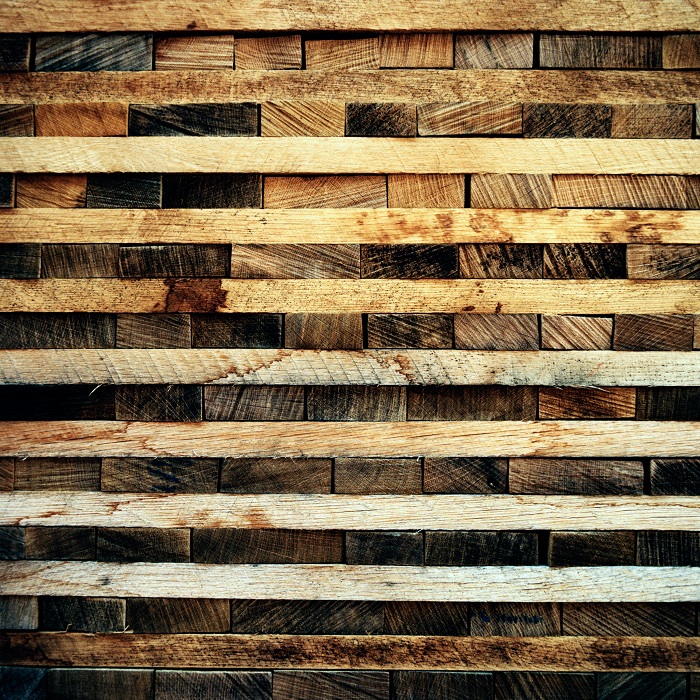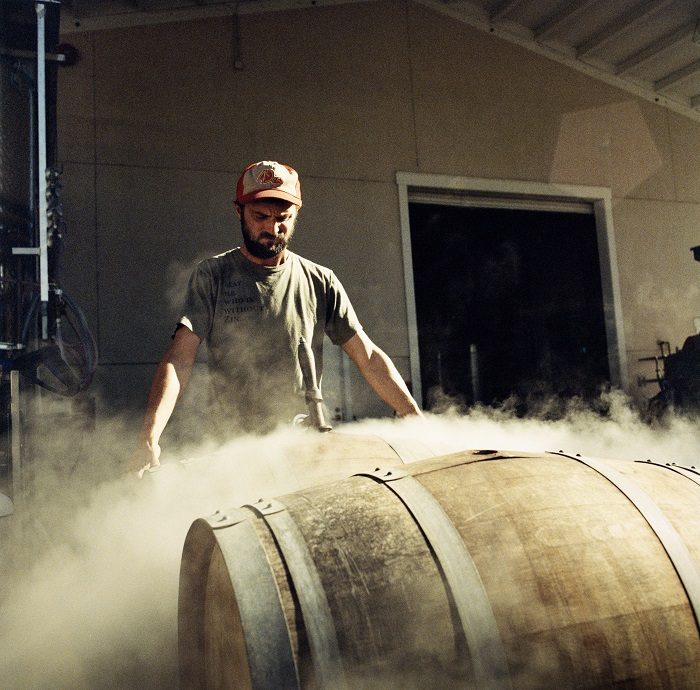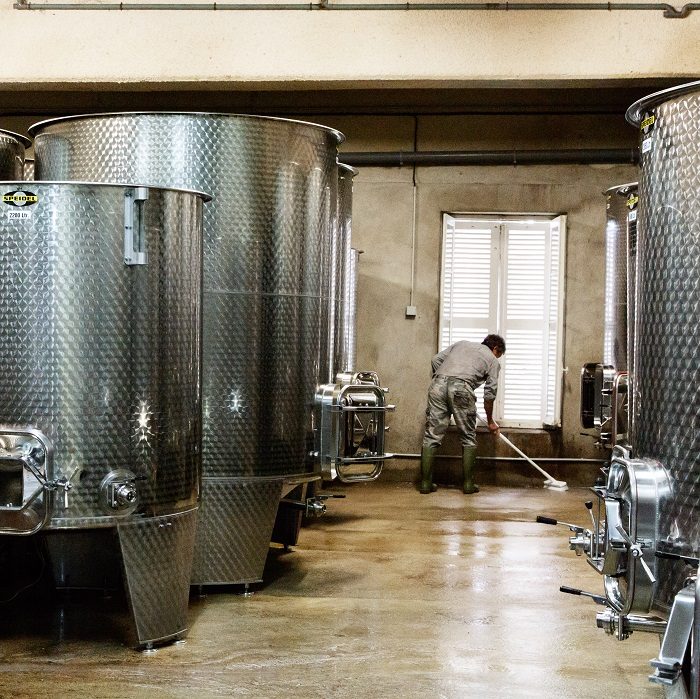Cask strength
Author: Martin Hudson MW

Planks of American oak being seasoned at Bodegas Vega Sicilia, Ribera del Duero. In time, these will be made into barrels that will hold a vintage of Único for a minimum of 10 years. Photographe: Jason Lowe
The oldest archaeological records of wine storage involve clay pots, rather than wooden vessels. Whether wood was used in ancient times is difficult to completely rule out, as wooden vessels are rarely preserved from antiquity, but evidence from sites as diverse as Anatolia, Georgia and ancient shipwrecks in the Mediterranean all point to clay amphorae being the preferred wine storage medium. Legendary underwater explorer Jacques Cousteau discovered some wine amphorae during a dive in the Mediterranean and, on opening a recovered vessel, was brave enough to taste the contents, which apparently were recognisable as wine but quickly turned to vinegar. This traditional method is still in use in Georgia and has been resurrected in wine-producing countries as varied as Spain and Chile. Clay pots do not impart any noticeable flavour to the wine they store (in wine-speak they are known as “inert” vessels), but they do allow a small amount of air to migrate into the wine. We will explore the importance of this later.
Some of the oldest preserved wooden wine vessels in Europe come from Germany around 2,000 years ago, and are not of oak, but rather the locally much more numerous and easily worked pine, which may have conferred on the wine a flavour not dissimilar to that of retsina. So why has oak become the wood of choice for all things vinous?
The reasons are identical to those justifying its long term use for building ships – it is relatively plentiful in Europe (the birthplace of the grapevine), it is waterproof and it is strong. There is a story of a Dane who in the late 20th century informed the royal family that the trees contracted for the navy were now ready, and asked if perhaps they would like to purchase them. In Denmark an emergency planting programme of oak had been instigated two centuries earlier, following the wholesale removal of all timber from the sacked Danish shipyards by the Royal Navy in 1807.
Oak is durable and waterproof, but what else makes it so good for storing wine? Firstly, as an organic entity with pores, it allows the passage of microscopic amounts of air into the wine. The oxygen in the air reacts with chemicals in the liquid to change the character of the wine in a beneficial way. In particular, the tannins found in red wine are linked together or “polymerised” by oxygen to form less aggressively bitter molecules, and can also combine with some of the colouring to make colours more long-lasting and attractive. The wood itself can contribute tannins to the wine, giving a wider spectrum of tastes and textures. Oxygen will also participate in reactions involving the acids in wine, rendering them softer to the palate. The most obvious effect of oak, however, is that it releases flavour compounds, especially vanillins, that add to the palette of flavours that emerge in the glass. The barrel-making process, discussed below, will also create sugars on the inner surface of the vessel, adding a subtle sweetness to the wine.
Not all oaks are created equal, in winemaking terms. The European oak, quercus robur, has a different array and concentration of flavour compounds to its American cousin, quercus alba. The former generally has more spicy and subtle flavours than the latter’s overtly vanilla character, so characteristic of Bourbon whiskey, but the flavours can be modified and amplified or attenuated by the barrel-making process. Where an oak grows also has an effect – French oak is particularly valued because the country’s temperate climate makes the trees quite slow-growing, giving a particularly tight grain that slows both the release of flavour compounds and the transmission of air, however oak from Bulgaria, Hungary, Slavonia (more or less contiguous with Croatia) and areas of Russia amongst others is also valued for winemaking. Winemakers are very conscious of the subtle effects of provenance on the quality of the wood, with many looking for wood from specific forests within France, such as Nevers, Allier or Tronçais. Perhaps the most extreme example of this quality control is Denis Jamain, who only uses barrels made from his own forest!

A cellar hand uses a steam hose to clean a barrel at Frog’s Leap in Napa. Photograph: Jason Lowe
Sometimes the choice of oak source may seem surprising – many top-end producers of Californian Cabernet Sauvignon such as Opus One use French rather than American oak, as they desire the more subtle flavours this yields. Traditional Riojas, such as those made by La Rioja Alta, often use American oak, rather than nearby French oak. This a result of history, from the period when large tracts of what is now the USA were Spanish territories and imported American oak was found to have a great affinity with Spanish grapes. Similarly, in Australia American oak has traditionally been used for Barossa Valley Shiraz, but more producers like Duane Coates are now adopting French oak, especially for the subtleties of Adelaide Hills Pinot Noir.
Barrel-making is a centuries old tradition. Trees selected to produce barrels are typically 100 to 200 years old and with a straight form. The wood is sawn into planks that are then dried, either by storing under shelter outdoors for up to two years, or more rapidly by kilning. The former process generally better preserves the desirable flavour compounds, but is more expensive. The barrel staves are then sawn or split into shape – American oak, because of the nature of the pores in the wood can be cut by saw and will remain waterproof, whereas European oak must be split along the grain to maintain its integrity. The staves are then traditionally toasted over an open fire prior to being formed into the characteristic barrel shape by cinching them together, with steel hoops fitted to hold the barrel body in shape.
The duration and intensity of the heat treatment will affect the degree of charring or “toast” on the inside of the staves, which will confer more or less toasted, smoky flavours to the wine and create more or less sugar on the inner surface. Finally the ends are added, bung holes bored and the barrel is ready to be shipped to the winery. The effects of cooperage are well known to winemakers. Paul Draper of Ridge in California believes in sourcing locally if possible, so uses American oak, but the care with which trees are selected, the length of time spent seasoning the wood and the subtle toast level used make the flavours these barrels yield almost indistinguishable from French oak.
How much flavour a barrel adds to wine will also be affected by a number of factors we have not yet considered. The first is the capacity of the barrel: the bigger the volume contained, the less flavour will be imparted to each bottle. In Bordeaux the traditional barrel size is 225 litres, and in Burgundy 228 litres, but throughout the world of wine, people are experimenting with barrels of greater sizes to give more subtle oak influence, particularly in Australia, where 300- and 500-litre sizes are common.
The next, equally important, factor is how often the barrel has been used – the first time a barrel stores wine, it imparts the greatest impact on flavour, diminishing with each subsequent use until, by the time it has been used three or four times, it is the air transmission which has the biggest effect. A visit to Selbach-Oster in the Mosel or Giuseppe Mascarello in Barolo will yield the sight of huge, venerable fuder or botte which are not yielding any flavour compounds to the wine they store. Arguably the most extreme use of non-flavouring wood is in the world of fortified wine, where producers of Port, Madeira and Sherry deliberately season their barrels prior to use to prevent any overt oak character detracting from their handiwork (although very old Oloroso Sherry will occasionally have a tannic character picked up from long ageing in the solera’s butts).
Are other woods used for maturing wine? Well, yes, but oak is by far the dominant variety. In the Loire valley producers such as Château des Armuseries and others have some acacia barrels in their cellars. The flavours these yield seem to particularly suit the local Chenin Blanc wines. Elsewhere, particularly in Piedmont, chestnut is traditionally used for its more subtle flavour profile.

Spotless stainless-steel tanks in the cuverie at Domaine de Montille, Burgundy. Photograph: Jason Lowe
What other materials are used for holding wine? We have already seen that clay vessels were used in antiquity, for fermentation, storage and transportation, but, more recently, concrete and stainless steel have been deployed for the former task. Concrete has very good thermal insulation characteristics, making it an excellent choice for fermentation vessels, where it self-regulates the heat generated by the fermentation process. In Bordeaux, the use of concrete vessels for this purpose is increasing, as steel is viewed as being too inert, not allowing the fermenting wine to “breathe” and consequently risking sulphurous reductive odours and flavours. Interestingly, reductive flavours were never a problem in the days of brass fittings, as the copper in the brass removed all excess sulphur.
Bare concrete tanks do cause the quite acidic wine to absorb calcium, however. This can be overcome by coating the tanks with an epoxy lining, but this can cause chemical taint to the wine. The great virtue of stainless steel as a wine-holding vessel is that it can easily be cleaned to prevent the risk of microbial spoilage. Stainless steel was adopted for fermentation and bulk storage of wine from the early 1960s, replacing large oak vessels and often concrete tanks that are now back in fashion. Stainless-steel fermentation tanks with temperature-controlling water-filled coils or jackets have enabled a range of very clean, fruit-expressive white and red wines to be made. Arguably, the ready access to such vessels made for the dairy industry powered the rise of the now ubiquitous New Zealand Sauvignon Blanc, as typified by Cloudy Bay. Historically, mild steel tanks were also used, but lined to prevent contamination by corrosion, the linings often being vitreous enamel or epoxy. In the Barossa Valley, Elderton use some old steel fermenters that previously made Penfolds Grange. These are waxed each season prior to use.
Much of today’s wine is shipped in bottle, ready for sale, but in the past wine was shipped in bulk, in barrel, and then bottled at the end market. In the 17th and 18th centuries the bottles were more valuable than the wine, and would not only be monogrammed to show their ownership, but would be presented to wine merchants for re-filling from barrel on a regular basis. At Berry Bros. & Rudd, the bottling line at Basingstoke was closed as recently as the 1990s, with casks of Claret being kept on the first floor, and gravity-fed to the bottling line below.
In another example of wheels coming full circle, wine shipment in bulk is an increasing modern phenomenon, but now the vessels used are large stainless steel tanks or – more prosaically – a giant single-use plastic bag held in a standard shipping container. Such bulk shipments can yield significant transport cost savings, vital in the very competitive entry-level price point for wine. By contrast, some European quality wines, such as Sherry, which were historically shipped in barrel, must now be bottled in the region to comply with their Product of Designated Origin regulations. This has had the unexpected consequence of forcing Scotch whisky producers to look for alternative sources for barrels, leading to the rise of Bourbon cask whiskies, as the regulations for Bourbon insist that a cask may only be used for maturation once.
Oak influence in wine is quite a controversial subject, with some consumers actively disliking the flavour that oak adds, particularly to some white wines. Nevertheless, it remains part of the “gold standard” for great white Burgundy and other classics including Rioja, Sauternes and Napa Cabernet Sauvignon. The world of wine is a fashion industry, albeit moving more slowly than the world of popular music or clothes, and it is undeniable that the pendulum is currently swinging away from overt oak flavours in the glass.
This has possibly been accelerated by the increasing consumer rejection of cost-cutting measures to attain that oak gloss. A 225-litre barrique from a top French cooperage will cost in excess of 1,000 Euros, so adding approximately £3 to the price of a bottle – and that’s before the additional labour costs of dealing with barrels are taken into account. Cheaper options that have been utilised are the incorporation of oak staves in a “signpost” configuration into a steel fermentation tank, or the adding of oak offcut chips in a glorified teabag. The most extreme practice, not allowed in the EU, is the adding of extracted oak essence in liquid form. The difference in flavour quality is analogous to using a vanilla pod versus inexpensive essence or, perhaps more pertinently, drinking a cheap gin compared with a London Dry or Distilled example.
So what is the future for oak in the world of wine? Does its historical dominance guarantee a future pre-eminence? It remains part of the armoury of options a winemaker has at his or her disposal to mould the character of their wine, and arguably is more safely positioned for the future than its botanical cousin cork. It is durable and sustainable. Oak confers additional flavours and textures to wine that many rejoice in, particularly when given sufficient time in bottle to meld with the fruit. Increased understanding, much garnered by detailed research by coopers, has enabled a more sensitive incorporation of oak into the winemaking regime. But, ultimately, like so much of wine, oak is a matter of taste.
Stainless steel
2015 Berry Bros. & Rudd Chablis by Domaine du Colombier, Burgundy: This is fermented and matured in stainless steel tanks to preserve the purity of green apple and citrus fruit.
Concrete
2012 Châteauneuf-du-Pape, Domaine de Marcoux, Rhône: Marcoux believe that concrete over oak allows the wine to show a true expression terroir. The concrete tanks are temperature regulated to give optimum control in the winemaking process.
Clay
2014 De Martino Viejas Tinajas Cinsault, Itata Valley, Chile: Terracotta amphorae go back to the origins of winemaking and the belief is that they are the least aggressive vessel for wine to ferment in. The resulting wine has rich, well-defined fruit and soft tannins.
French oak
2006 Sarget de Gruaud Larose, St Julien, Bordeaux: This is classic, mature Claret, with the French oak adding cigar box, wood and spice notes to the black-fruited, savoury palate.
American oak
2004 Viña Tondonia Tinto Reserva, Bodegas R. López de Heredia, Rioja, Spain: This is old-school Rioja: American oak adds a vanilla sweetness to the red fruit, while the prolonged air contact during the ageing process gives a long, leather and nutty finish.
Slavonian oak
2012 Barolo, Falletto, Bruno Giacosa, Piedmont, Italy: The use of large old Slavonian botte softens the aggressive tannins of the Nebbiolo grape, but adds little overt flavour to this wine.



[…] http://bbrblog.com/2017/07/18/cask-strength/ […]